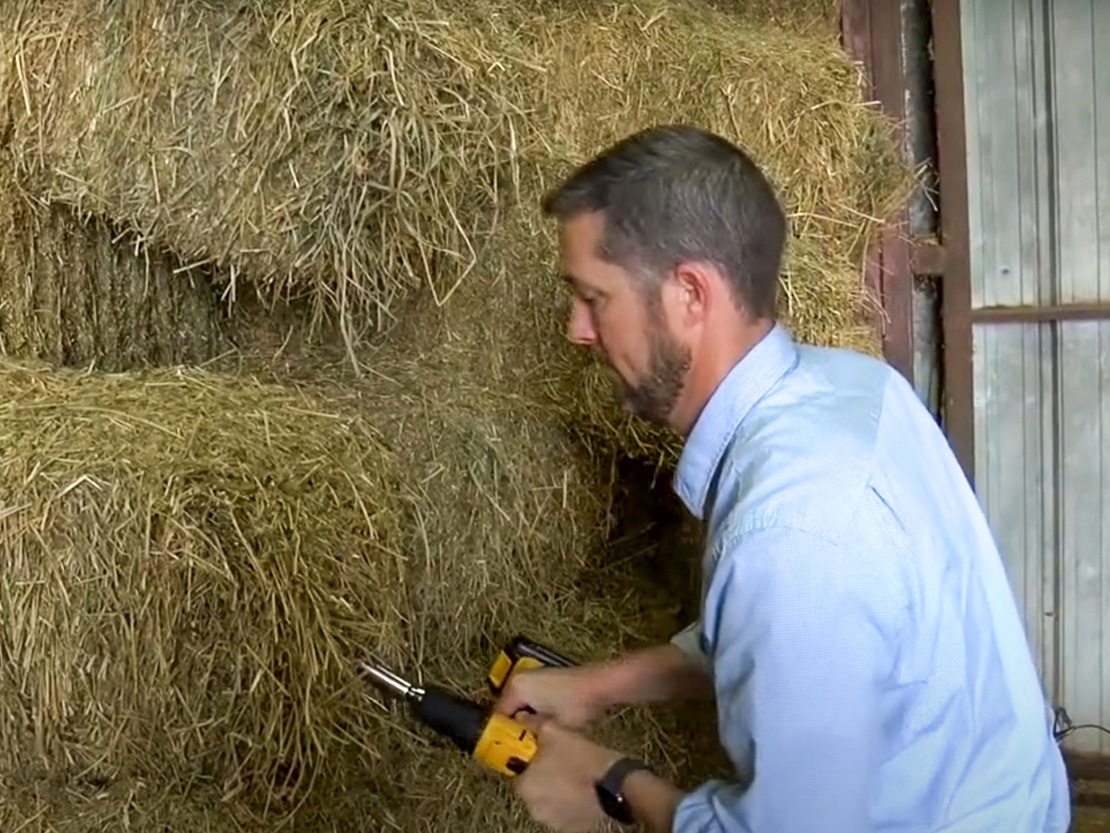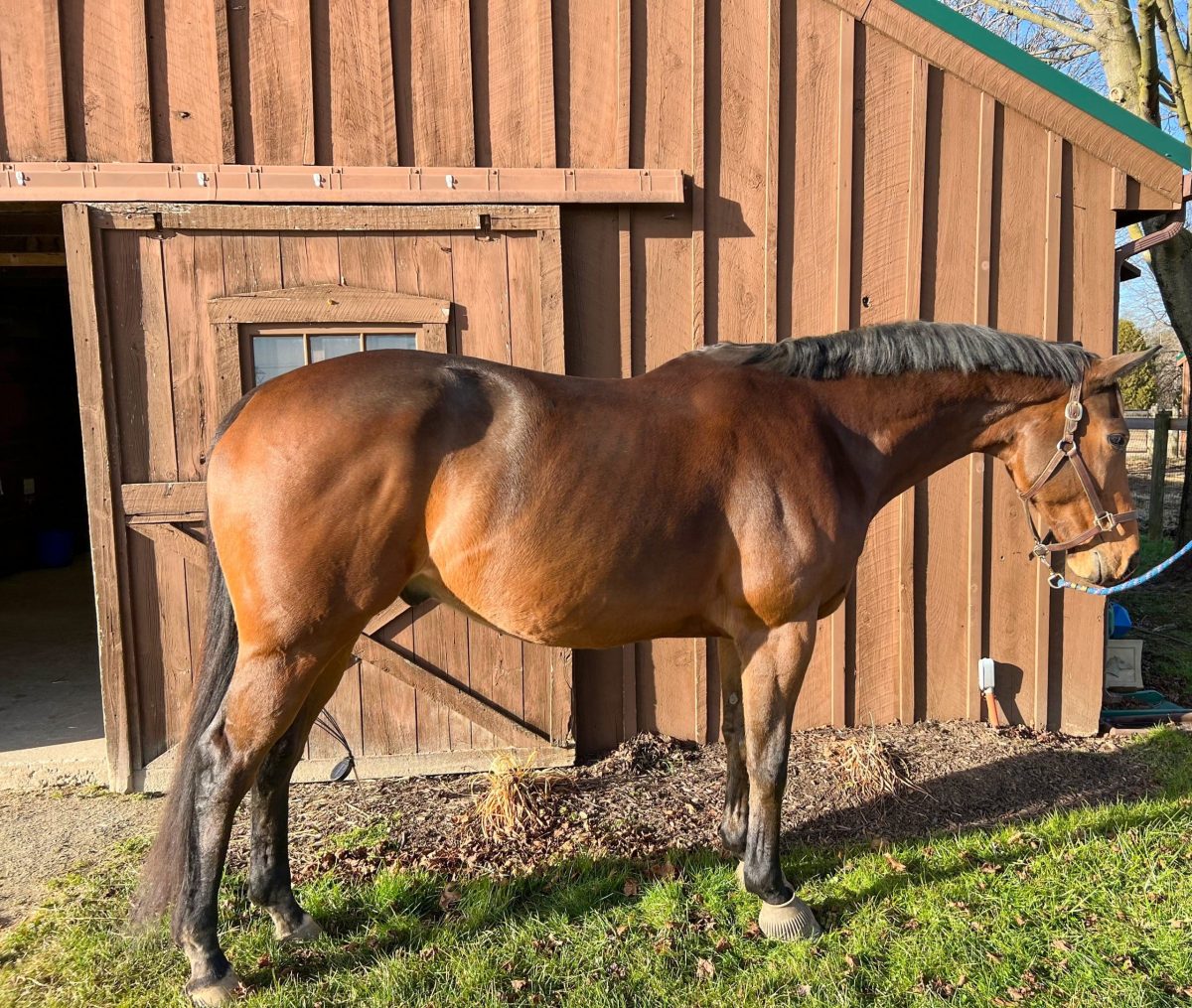Owners often turn to old wives’ tales, Google or Facebook with questions about feeding their off-track Thoroughbred (OTTB). Instead, we’ve gone to two experts for insight about feeding Thoroughbreds and what advice we should avoid. Morgan McQuerry, MS, PAS, director of emerging markets at Hallway Feeds, in Lexington, Kentucky, and Cassie LeMaster, MS, extension agent for Polk County, North Carolina, weigh in.
Focus on Forage First for Thoroughbreds
Both stress that forage made up of grass and/or hay should be the foundation for any horse’s diet, but particularly for Thoroughbreds. Horses need to consume a minimum of 1.5-2% of their body weight in forage daily. So, a 1,000-pound horse needs at least 15 pounds of high-quality grass or hay.
The experts stress that it’s important to feed each horse as an individual. While some horses and some breeds tend to be easier keepers than others, high-quality grass or hay is always essential. Next, they all need vitamins, minerals and protein in the right amounts. Beyond that, the horse that is growing or working hard, for instance, needs more calories than the horse that is only ridden once or twice a week.
It’s helpful to think of grain (concentrate) as supplementing the forage diet, rather than thinking “feed first.” The more horses can have their caloric needs met from grass or hay, the better. This is especially true for Thoroughbreds, which might be prone to ulcers. Keeping forage in front of a horse for most of the day is the most natural defense against ulcer development.
The logical next question is, “So how do you know if you’re feeding quality hay?”
Again, both experts say, “Have it tested.” McQuerry says that Hallway Feeds provides the service for their customers, as do some other feed companies. “It’s especially helpful to work with your feed supplier. They should be able to interpret your hay analysis and can formulate or recommend a feed to meet your horse’s needs.”
LeMaster suggests that if extension agents are available in your area, you could get them to come out and obtain a hay sample with a drill and core sampler. Sometimes owners may be able to borrow a core sampler and drill from their extension service to obtain a sample themselves. She says it’s easy to use.
From there, the extension agent can recommend the appropriate lab for testing. LeMaster mentions that often hay suppliers test their hay before sale. So even if you’re buying just a few bales at a time from the local feed store, you should ask. That information might be readily available.

Having your horse’s hay tested is key to knowing what nutrients he is consuming in his forage. Many horse feed companies provide this service. Photo courtesy Hallway Feeds
Know the Horse’s Body Condition Score
Once you know the nutrient content of your hay, you can address the horse’s calorie needs. It’s a huge help to know his body condition score. Horses are scored on a scale from 1 (poor) to 9 (extremely fat) in six areas where their bodies deposit fat – neck, withers, spinous processes (the parts of back vertebrae that project upward), tail head, ribs and behind the shoulder. Our sources note the ideal score for a Thoroughbred is 5.5.
McQuerry says that for Thoroughbreds and horses in general, feeling the ribcage is helpful. For your average horse, at 5.5 you’ll be able to palpate and feel his ribs without having to push through multiple layers of subcutaneous fat, though the ribs won’t be visible. As horses age, especially if not in regular work, they tend to lose topline muscle, so the withers, back and hip bones appear more pronounced. Weight tapes can be helpful if used consistently – i.e., comparing one month to the next, or this April to last April – but aren’t necessarily accurate in terms of the weights shown on the tape. McQuerry says she’s seen them be off by 200 pounds for a particular horse.
McQuerry and LeMaster both say they help owners “retrain their eye” when it comes to the best weight for a particular horse.
McQuerry adds, “So if the horse is maintaining its weight alone on pasture or forage, at Hallway Feeds we come in with a product like Stamm 30 (a ration balancer) to meet the protein, vitamin and mineral requirements that are not available in their hay or in pasture. Depending on the horse’s needs, when we see how much weight this horse needs to gain and what his workload is, then we’ll pick a feed to complement the forage program. For instance, a typical, middle-aged gelding with minimal energy requirements that needs a little bit of weight might go with six pounds of Equibility, which is 12 percent protein, 8 percent fat. It’s going to include all the vitamins and minerals from Stamm 30.”
Contrary to popular opinion, not all Thoroughbreds need grain for energy, though most need at least a ration balancer for the additional vitamins and minerals not found in the forage they’re consuming. But when horses are working hard, growing, pregnant, or lactating, they need more calories than the horse that is only ridden occasionally.
A key element in helping a horse maintain body condition is dental health. Sometimes the diet is adequate, but if the horse has teeth problems, he can’t break down and use all the nutrients you’re providing. Therefore, routine dental care is important, particularly for older horses.

Estimate your Thoroughbred’s body condition score using palpation and a visual assessment of the six areas where fat is distributed in the body: the neck, withers, loin, tail head, ribs, and shoulder. Photo courtesy The Horse/Haylie Kerstetter
Other Notes on Feeding Your OTTB
Thoroughbreds are hardy horses, especially when you consider the many jobs they perform. But when a horse develops a problem, it can be tempting to turn to the internet, where much of the nutrition advice found can be lacking context, wrong, or at least not helpful.
Your veterinarian or an equine nutritionist is best equipped to advise you on your horse’s specific condition and how it could be approached with diet.
Hydration. When it comes to hydration, an idle horse that weighs around 1,100 pounds usually drinks five to 10 gallons of water daily, unless the weather is notably hot or cold. If the horse is working hard or it’s particularly hot, that amount can shoot up to a 20 gallons per day. Be sure to keep an eye on your horse’s water consumption because any changes can be early signs of health issues. And remember, always provide your horse with access to clean, fresh water.
Steer Clear of Trends for Feeding Horses. For instance, horse people often believe a fat horse is a happy horse. Excessive weight, however, can bring on health problems.
Supplementing Thoroughbred diets. Then there’s the never-ending quest for the perfect supplement regimen for your horse.
Quickly jumping to the next greatest feed supplement for any perceived problem isn’t necessarily going to help; it typically takes at least a few months to see most supplements take effect. Consult an equine nutritionist or your veterinarian before adding supplements to your horses’ diet that might not be necessary.
Don’t forget pasture management. Importantly, how you maintain pastures also affects your horse’s nutrition. A pasture might appear healthy but, when you walk out there, you find it’s mostly weeds. Because grass typically makes up a good portion of the horse’s diet, maintaining pastures, fertilizing appropriately and giving pastures time to rest are all important.
Take-Home Message
Years ago, many horse people believed feeding oats was enough, but now we know that while it’s a good grain, oats alone lack the vitamins and minerals horses need for optimal health.
Equine nutritionists have researched the benefits of forage-first diets and determined the nutrient levels horses need, and feed manufacturers have designed products to fulfill those requirements. Horse owners seeking guidance on how to feed their Thoroughbred have many good resources available, from feed company professionals and independent equine nutritionists to extension agents and sourced online articles such as those in the RRP’s education library.

